
~ William E. Mutschler

~ William E. Mutschler
Mrs. Kemper Campbell
by Eva Neal
Mrs. Kemper Campbell, with her husband and their law partner, Mr. Sorenson, acquired the Verde Ranch in 1924. Mrs. Campbell, now 76 years of age, recalls that the original Verde ranch was approximately 4000 acres. The Campbells retained the north portion of 1900 acres, while Mr. Sorenson retained the south portion. Part of the Kalin ranch, from the south portion along Bear Valley Road, is now being developed for the new Victor Valley College.
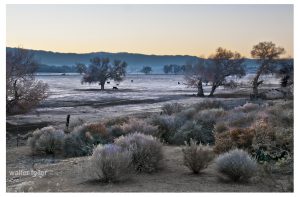
Mrs. Campbell describes the red House is consisting of nine rooms and in good repair. The “red house” was built in 1870 by John Brown Sr. and was used by the Mormons as a hotel and stopover. It was a meeting place of the pioneers on their journeys south to the San Bernardino Valley. In 1867, John Brown homesteaded the Verde Rancho, which became the first major ranch of the Mojave River Valley. Horse and cattle raising and production of alfalfa have been the major uses of the ranch by a succession of owners: the Coles, Sterlings and Greers before the Campbells and Mr. Sorenson became owners. The Campbells operated their portion as a working ranch. In the 1930s they added attractions for guests, and for many years it was well known as the “North Verde.” after the death of their oldest son during World War II the name was changed to “Kemper Campbell Jr. Ranch” in his memory.
Adapted from Mohahve I – Scrapbooks of History, page 93 – Mohahve Historical Society
in the summer of 1845, Benjamin D Wilson, own part of the interest in the Jurupa Rancho, site of the present city of Riverside, led a troop of Calvary in search of cattle rustlers.
Setting out from San Bernardino Valley, he divided his command. Most of the men he sent through Cajon Pass, keeping only 22 Mexican troopers with him to follow a trail across the mountains. Two days later, Wilson and his men reached the lake where they sighted scores of grizzly bears.
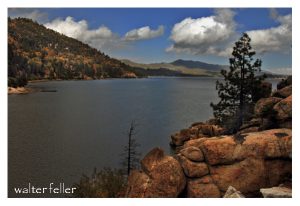
Most of the soldiers had been vaqueros. They formed in pairs and drew reatas, each pair attacking a bear. One looped a rope around bear’s neck; his companion roped same bear by a hind foot. Then the men drew apart to stretch the rope taut and hold the bear a prisoner. They bagged and skinned eleven bears, stretched their hides and continued across the mountains to join the rest of the command on the desert at Rancho Las Flores, on the Mojave River.
Here the reunited party engaged Indians in a fight, after which Wilson and his 22 vaquero-troopers returned home by the way of the lake. They again found the place overrun with bears, and the same 22 soldiers brought in eleven more bears– enough to give them a bear rug apiece as a trophy. It was then that Wilson gave the name of Bear Lake to the little body of water.
Years later the name was changed to Baldwin Lake. The name survives, however, in Big Bear Lake which was created in the site of the Talmadge Ranch in 1884 when a dam was built to provide a constant water supply for the Redlands District.
–
adapted from ~ Pioneer Tales of San Bernardino County – WPA – 1940.

Johnny Lang set out one day in 1894 to search for a lost horse. He ran smack into a band of rustlers and found a fortune in gold.
Johnny was plodding over the little San Bernardino Mountains, in that area known today as Joshua Tree National Monument, Where masses of rock form fort-like walls around hidden valleys and grass meadows. Here it was that the rustlers pastured their stolen stock. They ran choice cattle and horses ranches in Arizona, into the little San Bernardino’s ( by easy stages), and from there they spread through Southern California, selling their contraband herds.
The first thing Johnny knew one of the rustlers lookouts who drew a gun and threatened him. ” You ain’t lost no horse,” the gunman said. “Git going!”
Johnny made his way back down the mountain and return to the camp. There he met another prospector, a stranger, who pointed out a nearby hill as a likely spot to dig for gold. Johnny took his advice. He found a rich outcropping of ore and staked out a claim which he called the Lost Horse Mine.

News of the strike brought on a gold rush– and that was the end of the last great band of organized rustlers entrenched in California. The minor sworn to the hills and valleys and drove the rustlers from their hideouts. Johnny Lang made fortunes during his lifetime and never saved up any. One day in 1928 he was found dead. He died with his boots on, still searching for gold in the wilderness of rock.
adapted from ~ Pioneer Tales of San Bernardino County – WPA – 1940.
More about Johnny Lang & the Lost Horse Mine:
http://mojavedesert.net/people/lang.html

The Mormon Road going south across the Oro Grande Wash would come up and head straight into the Joshua trees and juniper woodland. The slope was fair, the ground hard and the trail reasonably straight. There were variations, though. To the eyes of one, one way around a bush may look easier than it does to another. Trails evolve. If one branch is significantly better than another, that branch becomes wider and more popular. These branches and shortcuts may join together later. These variations due to mankind and weather begin a process I have heard to be called, “braiding.” It is quite possible for the main alignment, the busiest, the center-most version in the corridor to remain in use providing its continued existence to this very day.
The Indians had their trails which existed from before there was time and these trails went their natural way–from fire hydrant to fire hydrant. Explorers, typically in a hurry escaping from an attack, had to climb the fence. Pioneers had to cut a hole in the chain link and disassemble their wagons and carry them through the gap.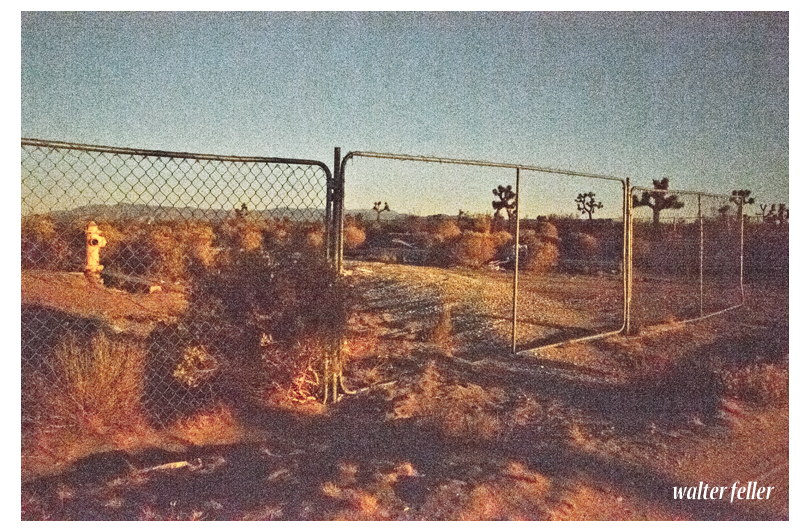
Then the bicyclists came and largely suffered flat tires and getting stuck in soft sand. Then we thought, “Why not use cars and trucks?” Then we built freeways that went around this unnecessary fence and stuff.
The End.
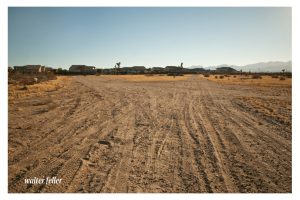
There is a book titled “Trails across the Mojave” that describes a fork in the Old Spanish Trail that splits off to John Brown’s toll road on the left and the Mormon Hogback and Sanford’s Pass to the southwest. Now the photo showing the fork located according to the directions provided most likely has no resemblance to what the original trail looked like if it were indeed at this particular point. I would say this fork is basically the same alignment in the same location as the trail was 150 years ago. The left goes to Cajon Summit while the right leads to Phelan to descend into the West Cajon Valley.
There is another important location to be remembered, it is the “Division of Trails” that goes over Cajon Pass. The word “Cajon” is Spanish and means “box”. The steep sides of the formidable mountain pass made the name appropriate. The rigors of El Cajon must be faced to arrive in San Bernardino Valley. The high Sierra Mountains were the last barrier to the weary travelers.
Here the trails divided. The left fork was the way used by the pack-trains of the Spanish traders and was called the Old Spanish Road. The other road was chosen by the Mormons for they had wagons which could not be pulled up or down the narrow canyon which the Spanish had followed. So, the Mormons made a bend westward to the right to avoid the higher portion of the mountains. This division of trails is today a a few hundred yards to the east of Highway 395 at the crossroad of Duncan Road.
The Spanish trail turned back to the left and slowly climbed the summit, entering the edge of Horse Thief Canyon. From there they traveled down grade about 6 miles until reaching Crowder Canyon (earlier called Coyote Canyon), then from Cajon junction the road went south which is located today on the present Highway 66. This section in the 1860s and 1870s was known as John Brown’s toll road.
Trails across the Mojave – Grace Jackson, Lucille Matson – 1970
San Bernardino National Forest
http://digital-desert.com/san-bernardino-national-forest/
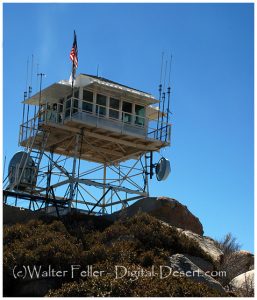 — Keller Peak Historic Fire Lookout Tower —
— Keller Peak Historic Fire Lookout Tower —
Keller Peak Lookout, a historic fire lookout tower, was built in 1926 and is the oldest fire tower still standing in the San Bernardino National Forest.
The lookout is little changed from its 1926 appearance, and it represents one of very few fire towers in California dating from before the Great Depression.
Keller Peak is still used during the high fire hazard months, and volunteer lookouts are on-duty between May and November.
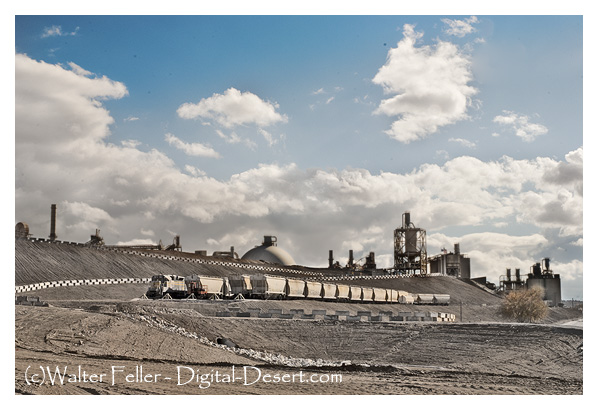
Riverside Cement in Oro Grande, CA started in 1907 as the Golden State Cement Plant. It was shut down during the depression and restarted as Riverside Cement in 1942. The plant was enlarged and completely rebuilt in the late 40s. In late 1997, TXI purchased Riverside Cement.
The first Mojave River bridge September 22, 1890 – September 26, 1890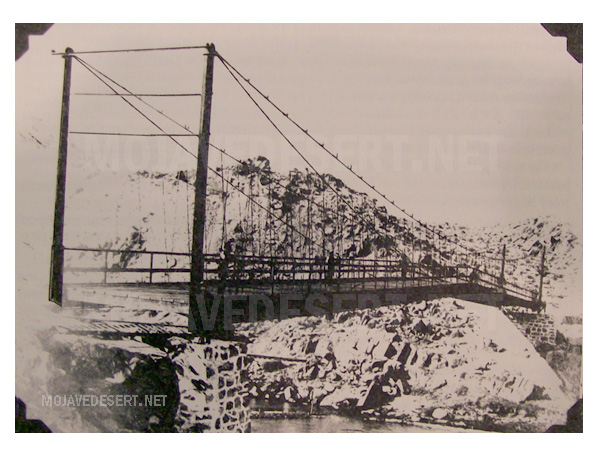
In 1890 a bridge was to be built across the Mojave River. The location just north of the upper narrows rather than further downstream at Oro Grande was chosen. A few days before the bridge was completed the county supervisors and an engineer visited the structure for inspection. The engineer was disappointed in the fact that the suspension bridge failed to meet specifications and could not do the job it was designed to.
The bridge was finished and prior to opening to the public a physical test was to take place. A large ore wagon loaded with 8 tons of rock and a trail wagon were pulled across the bridge by a boy, Austin Ellis, driving an 18 mule team. He made it. There was a lot of clapping and yelling and celebrating when all of a sudden a pillar collapsed and a suspension cable “disappeared like magic, sending up a volcano of dust. The bridge collapsed dumping the wagons, mules, the boy and five men and boy into the river 50 feet below.
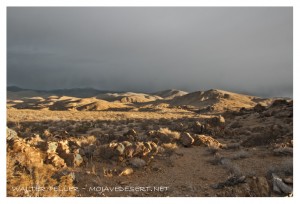 My friend’s mother used to tell me these stories about the desert. I loved them–nothing like sitting there listening to her–so interesting.
My friend’s mother used to tell me these stories about the desert. I loved them–nothing like sitting there listening to her–so interesting.
One story she told me was about a gentleman who found some gold. The gold was just laying there in this high, dry meadow at the top of a canyon which was at the top of a canyon at the top of yet another canyon. There was so much gold lying about free for the taking–right there in the open. The man took some home and sold it.
The man was of modest tastes and the money he had from the gold lasted quite awhile, but got spent as money tends to be. Of course he remembered the gold high up in the bare mountains, and there went and loaded up again. Over the years he went again and again. He didn’t need much so he didn’t take much, and when he died there was so much more left on the mountain. Just laying there.
My friend’s mom claimed this man told her where the place was. She said it was easy to get to yet required a little trickery to keep from being followed. “Nearly in plain sight,” she would tell me. A nugget or two or three here and there. Even now days no one gets suspicious. It doesn’t take much to live if you live a certain way.
During this phase of the journey the wagon train was doing much of its traveling at night, owing to the great daytime heat of the desert and the long distances between water holes. At regular intervals during the night they would stop for a short rest. At one of these rest stops, eleven-year-old Ellen Baley, a daughter of Gillum and Permelia Baley, fell asleep and failed to awaken when the wagon train moved on. Somehow, she was not missed until the train traveled some distance. The poor girl awoke to find herself alone in the middle of a vast hostile desert. Filled with fright, she began running to catch up with the wagon train, but in her confusion she took off in the opposite direction. When she was discovered missing, her father and older brother, George, immediately rode back to where they had stopped. To their horror, she was not there! Captured by the Indians must have been their conclusion! Nevertheless, they continued their search by calling out the little girl’s name at the top of their voices as they rode back.Their efforts were soon rewarded when, far off in the distance, came a faint cry, “Papa, Papa.” Her father immediately answered and kept calling her name until he caught up with her.When reunited with her family and the other members of the wagon train, Ellen had a tale which would be told and retold by family members until the present day.
from –
Disaster at the Colorado
Beale’s Wagon Road and the First Emigrant Party
The tiny community of Hi Vista, located in the Mojave Desert northwest of El Mirage dry lake, is a shred of what it once was and that being a shred of what it could have been, I suppose.
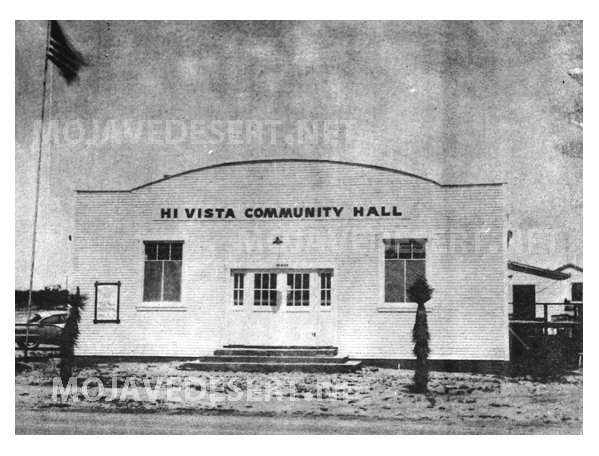
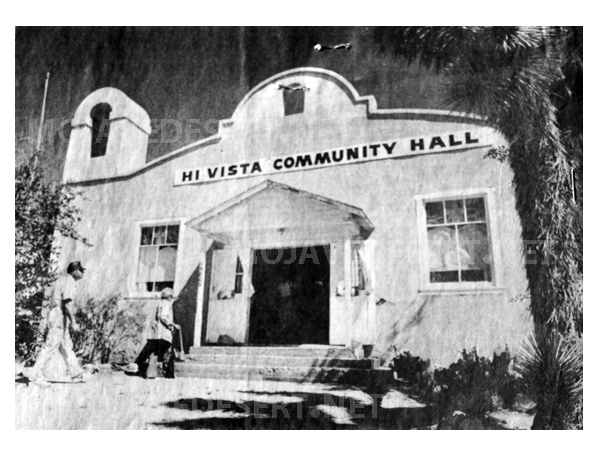
Over twenty years later when the movie Kill Bill (2003) came along, the hall was due for and given another facelift — a wood porch and cover were built on.
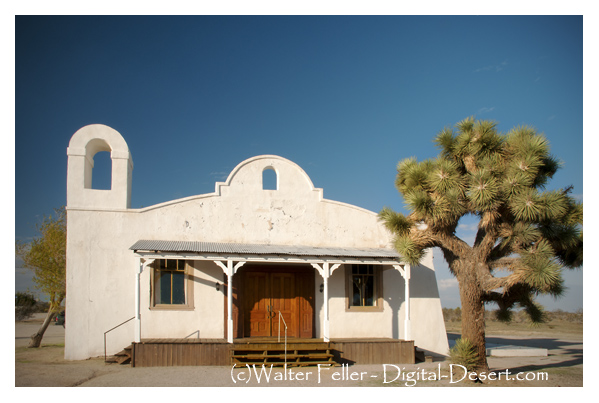
Note the Joshua tree on the right has appeared, at least in part, in each shot. This is visual proof that Joshua trees grow considerably faster than once thought.
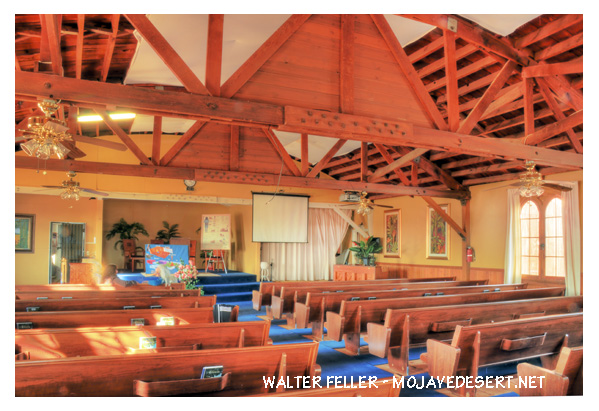

I have heard the Indians would go to the reeds in the riparian areas where aphids fed in large numbers, brush away the tiny bugs and scrape their shiny-sticky waste from the blades. En masse the material would be shaped into a large, heavy loaf with a hardness and sweetness similar to rock candy. In Jedediah Smith’s first expedition across the Mojave his guides recovered a cache of the sweet bread to supplement their then meatless diet.
“But men accustomed to living on meat and at the same time travelling hard will Eat a surprising quantity of corn and Beans which at this time constituted our principal subsistence.”
~ J.Smith, 1826
“Two men were in charge of a station at Egan Canyon in Nevada. One morning a band of Indians captured them, after a battle. The chief chose to make the prisoners feed his braves before murdering them, and compelled them to cook an immense quantity of bread. The Indians gorged themselves during the day, while the captives toiled and sweated over their cooking, probably no more cheerfully because of a promise that they would be burned at the stake at sundown. A wagon tongue had been driven into the ground to serve as a stake, and preparations for their roasting were in progress, when in true story-book style, a company of cavalry happened along and saved them. This was the narrative given out as absolute truth in after years given by one of the men.”

“BOOMER—Drifter who went from one railroad job to another, staying but a short time on each job or each road. This term dates back to pioneer days when men followed boom camps. The opposite is home guard. Boomers should not be confused with tramps, although they occasionally became tramps. Boomers were railroad workers often in big demand because of their wide experience, sometimes blackballed because their tenure of stay was uncertain. Their common practice was to follow the “rushes”-that is, to apply for seasonal jobs when and where they were most needed, when the movement of strawberry crops, watermelons, grain, etc., was making the railroads temporarily short-handed. There are virtually no boomers in North America today. When men are needed for seasonal jobs they are called from the extra board”
~ from Railroad Avenue, by Freeman H. Hubbard – 1945
Note on: Freeman Stage Station (Coyote Holes).

Freeman Station was established by the ex-stage driver Freeman S. Raymond in 1872. On the last day of February, 1874, the Station was attacked by Tiburcio Vasquez. Although the station occupants had surrendered, “Old Tex” (who was sleeping in the barn) awoke and fired at Vasquez, wounding him in the leg.

Vasquez returned fire and delivered a leg wound to Tex (Pracchia, 1994). In 1894, Freeman’s parcel became the first homestead in Indian Wells Valley.
~ R. Reynolds
Henry R. Mockle (1905-1981),
Illustrator of Mojave Desert flora
Rather than documenting the structure of each plant species in scientific detail, Henry Mockle intended his illustrations to capture “the pleasurable feeling at coming up on one of these little creations”.
As did naturalist Edmund Jaeger, Mockle took pride in all his studies of desert plants being taken directly from life. This work often involves lying on the ground for hours, in conditions ranging from hot to cold, windy to wet. As some annual plants – like the Phacelia – per growing up and through the protective spread of woody shrubs. Mockle found he had to lay beneath creosote bushes and other scrub vegetation to depict these wildflowers in full.
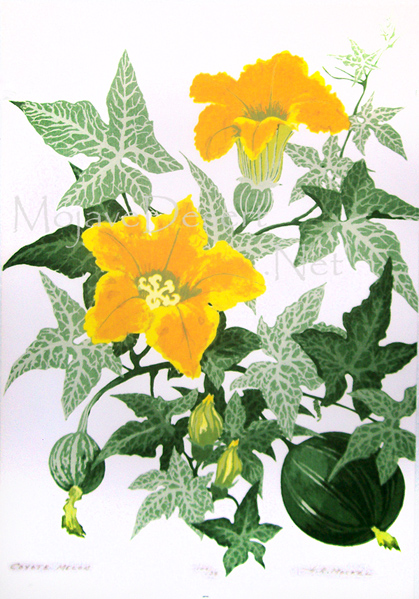
Source: Riverside Metropolitan Museum
In August of 1907 a brakeman at Cajon Summit station failed to secure a train while unhitching helper engines and over fifty cars began rolling out of control down the grade into the Victor Valley. After seven miles of plummeting down the tracks thirteen cars derailed. A few miles further thirty more cars failed to make the curve before passing through the Upper Narrows. One after another they hurtled into the river bursting into flames. There were cattle on the train too. Many survived the initial accident, but died soon afterward. The last nine cars, with a frightened local rancher on the lead caboose, rolled to a stop in Oro Grande.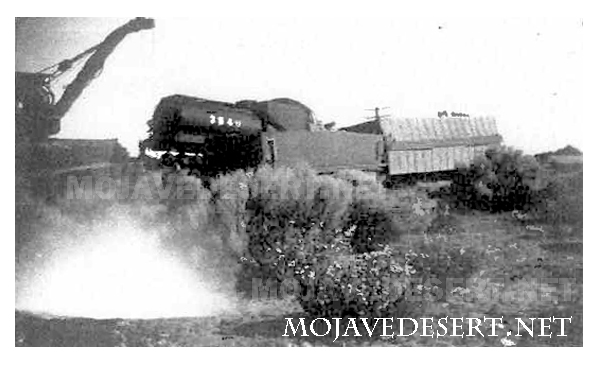
In the ashes of one car that burned for over a week, there were four hats found. The brakeman, it was discovered, had been selling rides to hobos for $1. Those at the scene agreed that there were at least that many that died. Photos – courtesy B.F. Minister
Photos – courtesy B.F. Minister
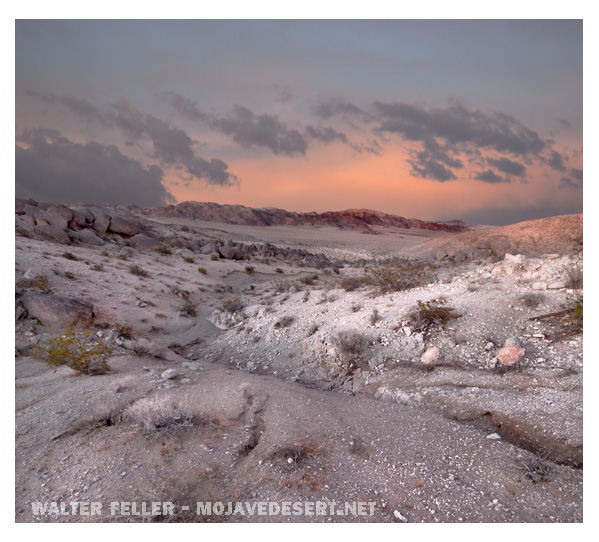
“The point of view is born of the desert herself. When you are there, face to face with the earth and the stars and time day after day, you cannot help feeling that your role, however gallant and precious, is a very small one. This conviction, instead of driving you to despair as it usually does when you have it inside the walls of houses, releases you very unexpectedly from all manner of anxieties. You are frightfully glad to have a role at all in so vast and splendid a drama and want to defend it as well as you can, but you do not trouble much over the outcome because the desert mixes up your ideas about what you call living and dying. You see the dreadful, dead country living in beauty, and feel that the silence pressing around it is alive.”
~ E. Bush-Perkins – The White Heart of Mojave
http://mojavedesert.net/
Hesperia, CA. pre-1950 – Then and Now
Jack and Margaret Nelson, were a very nice couple, who lived on the corner of Olive and E Street. They had three dogs, two were copper-colored police dogs, named Penny and Copper, and one chow dog, named sugar. My parents became very good friends with them. They had a cow, and we soon started buying our milk from them, until they moved away.
After the Nelsons left the area we started purchasing our melt from the Snell Dairy and Creamery Company that was located in Apple Valley. Dick and Winnie Weening took over the milk routes, serving all the high desert, as far as State Line in 1942. In 1943, the Weening family purchased the dairy and the name of Snell Dairy. The milk was delivered in glass bottles and the empty bottles were picked up with the next delivery. The milkman would even put the full milk bottles in the refrigerator. There will never be service like that again.
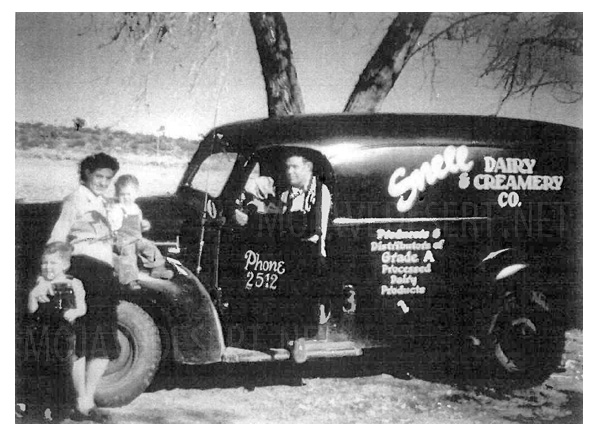
This photo was taken in 1945 or 1946, and was provided by Barbara Weening Davisson, daughter of Dick and Winnie Weening. She notes, that the picture is of the Johnny Weening, driver and Iva Weening Carpenter, with son Jerry (standing), Phil McGurn, being held.
~ Mary Ann Creason Dolan-Rohde
More about …
Hesperia, California
We did what shopping money would allow, at Roy Walters’ general store. We purchased some beans, flour and canned food items, (canned tuna for my mother and me and canned sardines were for my daddy) gas for the vehicle, and I remember ice for the icebox and we also picked up our mail. The post office was located inside of the store, in our mailing address was PO Box 166, Hesperia, CA. There were no ZIP Codes back in those days.

The store was indeed a general store. They carried just about everything a person would need. There was a glass enclosed section that had any candy, which always drew my attention. There was a very large glass jar that sat on the counter that held dill pickles. I remembered these, because I liked both. There were shelves with items all the way from food, medicine, cosmetics two blankets. I remember a large cabinet that had a lot of small drawers, with labels on them. But I do not remember what was in the drawers. I think there were a couple wood barrels sitting on the floor and many items hanging on the walls. If I remember right, I think the butcher shop was located in the back of the store with a cold storage box to keep the meat from spoiling.. I do not remember if the bread was sliced. But I do remember that oleomargarine, (butter substitute) was non-colored and you had to mix a yellow powder packet into it, to make it yellow.
There was a wooden barn that sat next to the store, where the hay and grain was stored. The gas pump was located in front of the store. I only remember one, but there must’ve been to. I am not sure what brand gas they sold. I do remember that you could buy oil for your vehicle or what equipment you might have at home. I do not remember, but going by the fact that the Walters store carry just about everything, I would guess they also sold batteries for your vehicle and equipment, else well as for your radio and flashlight.
For the longest time, they had the only telephone in this area. And going by history, the railroad station had a telegraph office. The Hesperia depot set almost across the street from the store.
Roy and Laura were both extremely friendly and up on the latest gossip. Roy loved to talk, and so did my daddy, so they would talk for what seemed like hours.
Hesperia, CA. pre-1950 – Then and Now
~ Mary Ann Creason Dolan-Rohde
More about …
Hesperia, California

Our nearest neighbor, was a Dr. Nelson, who lived in the large rock house further up Highway 173 on the next bend in the road. He was a Seventh-day Adventist who spent weekends there and would manage to come to our house at dinner time. Daddy would always ask him if he would like to stay for dinner, and he would always say yes, and eat meat. Our neighbor on the other side, which would have been on Lake Arrowhead Road, was an old man my daddy called ‘Billy Goat’ Thompson. My guess is, that his real name was Russell Wilson Thompson, but because he raised goats, people had given him the name of ‘Billy Goat’ Thompson. He was a rather dirty man, with a tattered clothing and a beard. I remember that he lived in a cave and had a number of working herd dogs, that I enjoyed watching. I remember that he had a very gentle voice and that he loved his animals.
Hesperia, CA. pre-1950 – Then and Now
~ Mary Ann Creason Dolan-Rohde
More about …
Hesperia, California

One day a man passed by a ranch and saw a beautiful horse. Hoping to buy the animal, he said to the rancher: “I think your horse looks pretty good, so I’ll give you $500 for him.”
“He doesn’t look so good, and he’s not for sale,” the rancher said.
The man insisted, “I think he looks just fine and I’ll up the price to $1,000.”
“He doesn’t look so good,” the rancher said, “but if you want him that much, he’s yours.”
The next day the man came back raging mad. He went up to the rancher and screamed, “You sold me a blind horse. You cheated me!”
The rancher calmly replied, “I told you he didn’t look so good, didn’t I?”
Shorty Harris
Single Blanket Jackass Prospector Shorty Harris’ burial beside Jim Dayton in lower Death Valley was quite an occasion. Four hundred CCC boys, an army chaplain and a goodly gathering of desert rats and interested visitors gathered at the site near Eagle Borax and awaited arrival of the hearse from Bishop, as the sun dropped to the crest of Telescope Peak.
 All day two old miner friends had been digging the grave aided and abetted by a jug of firewater hidden behind a clump of greasewood.
All day two old miner friends had been digging the grave aided and abetted by a jug of firewater hidden behind a clump of greasewood.
When the casket arrived and was measured the grave was too short as the diggers had figured on the length of the “Short Man” and not the coffin.
As the sun dropped behind the Panamints and the chaplain and mourners fidgeted uneasily, a voice came from the grave.
“Bend the so and so in the middle and let’s plant him. He won’t give a damn.”
However it wasn’t feasible to bend a coffin but it was lowered on an angle and Shorty was buried with his head up.
—Told by T.R. Goodwin, Superintendent Death Valley National Monument
Harry Oliver’s Desert Rat Scrapbook
Back before Route 66 made crossing the desert easy, three friends wanted to cross the Mojave. Of the three buddies there was a “smart dude,” a “not so smart dude,” and a “not smart at all dude.” Before they left the “smart dude” says, “We’ll meet here in an hour. Bring something useful to cross the desert with.”
An hour passes. All three friends return.
The “smart dude” says, “I brought some ice packs to keep our heads cool.”
The “not so smart dude” says, “I brought a pail of water to keep us properly hydrated.”
The “not smart at all dude” smiles real broad and says, “I brought a car door so I can roll down the window when it gets hot.”

The end.
Rattlesnake Flats
Way in back of a mining claim in a crack near a knob on a knoll up near Rattlesnake Flats there is some thick brush grown around a wobbly old picnic table.
Roy Rogers
My friend tells me that this table once belonged to TV legend, Roy Rogers. I believe this to be true. I am told that, well, look at it; it is a much longer table than normal. My friend has lived down the street and around the corner from the Rogers for years before Roy and Dale passed away. My friend is quite credible.
I sat at the table for a moment. I hardly had to close my eyes to see cowboy cuffed shirts, checkered table cloths, barbecued ribs, potato salad and hear some old time country western pop. The table spoke to me — it said, “Yep — they sat here.”
That is the story of this picnic table.
The end.